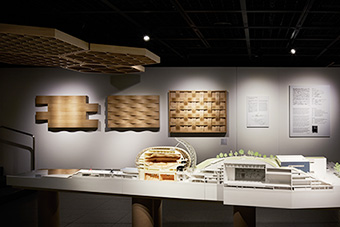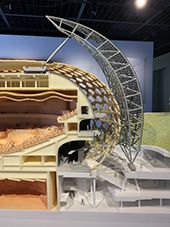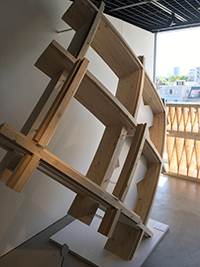 |
 |
 |
HOME > FOCUS > Architect Shigeru Ban: Investigating Material, Discovering New Potential |
 |
 |
Focus features two in-depth reviews each month of fine art, architecture and design exhibitions and events at art museums, galleries and alternative spaces around Japan. The contributors are non-Japanese residents of Japan. |
|
|
 |
 |
 |
Architect Shigeru Ban: Investigating Material, Discovering New Potential
James Lambiasi |
 |
La Seine Musicale (Paris vicinity, France, 2017). Architects: Shigeru Ban Architects Europe. Photo © Nicolas Grosmond |
For those familiar with the early career of Shigeru Ban, works that come to mind are those introducing paper tubes as a substitute for wooden structural elements. His vision transformed this simple element into a tool to realize spatial creations of great impact but modest economic means, and is still a symbol of his ability to focus on the inherent properties of materials to structure new spaces. Ironically, in his current exhibition at TOTO Gallery Ma, Shigeru Ban: Projects in Progress, there are no major projects on display that use paper tubes. As a testament to his dedication to explore new materials, he currently focuses on the magnificent potential of wood to support grand spatial structures that were previously assumed to require steel and concrete. With almost all of the exhibits representing projects in progress, one may witness firsthand the level of diversity that Ban has reached in the structure and fabrication of wood in order to attain such large-scale spaces. As one might expect, the highlight of each exhibit is the fascinating display of building mock-ups that convey the importance of conceiving of new spatial creations through the investigation of material and structure.
The major focus of the exhibition is La Seine Musicale, a music complex located on Seguin Island in the River Seine just outside of Paris. Just completed this year (2017), it is the largest built accomplishment of Ban's career, and likely to be hailed as the new symbolic gateway to Paris. While the majority of the building is quietly integrated into the landscape of the island, the major element is a circular concert hall formed by a wooden structure resembling a wooden basket. A four-meter-long section model and a time-lapse video of the construction explain the project in great detail. Life-sized material samples feature tiles that turn color according to the angle from which they are viewed, and green polycrystalline PV solar panels that rotate around the structure to provide effective shade on the glass façade at all hours of the day.
 |
|
 |
|
Exhibition view, La Seine Musicale sectional model. Scale: 1/150. Photo © Nacása & Partners Inc. |
|
Exhibition view, La Seine Musicale sectional model. Scale: 1/150. Photo by James Lambiasi |
While taking on large projects around the globe, Ban still remains committed to providing innovative solutions for places struck by disaster. Kumamoto Wooden Prefabricated Housing provided a quick and economic housing solution for residents of Mifune, Kumamoto after the earthquake disaster of 2016. A life-sized section reconstruction shows the innovative use of exposed structure, incorporating closet storage into the depth of its frame. Equally important, because of the lack of available carpenters at the time, the pre-cut plywood structure allowed for easy construction without professional training.
Exhibition view, Kumamoto Wooden Prefabricated Housing mock-up. Photo by James Lambiasi |
The Yufu City Tourist Information Center, located next to JR Yufuin Station in Kyushu, is expected to be complete in March 2018. Perhaps one could consider this a modern-day version of a gothic cathedral, as each of its columns extends up into four separate branches and arches into an elegant ceiling canopy. While the building model at first glance appears to be a simple rectangular glass volume, the 1 to 3 scaled mock-up of the wooden columns and arches conveys the remarkable space inside.
Exhibition view, Yufu City Tourist Information Center model and mock-up. Photo by James Lambiasi |
|
Exhibition detail view, Yufu City Tourist Information Center structure mock-up. Scale: 1/3. Photo by James Lambiasi |
"Watch Company Headquarters in Switzerland" is the head office for a major Swiss watchmaker in Biel/Bienne, Switzerland. Taking advantage of the highly advanced timber processing techniques in this region, the building structure consists of two very different timber framing systems that reflect the building usage. Wooden mock-up exhibits at scale 1/3 show the contrasting systems, one a rigid orthogonal columns and beam system, the other an organic curvilinear shell that extends along the site. An accompanying video exhibit shows the advanced fabrication at the Swiss factory, an impressive process of automated computer-controlled assembly lines reminiscent of a precision car factory.
Watch Company Headquarters in Switzerland (Biel/Bienne, Switzerland / Projects in Progress). Architects: Shigeru Ban Architects / Shigeru Ban Architects Europe. © Didier Ghislain |
|
Exhibition model view, scale 1/300, Watch Company Headquarters in Switzerland. Photo by James Lambiasi |
|
 |
|
|
|
Exhibition detail view, Watch Company Headquarters in Switzerland. S Wooden Grid mock-up. Scale: 1/3. Photo by James Lambiasi |
As conveyed in the title of the exhibition monograph, the work of Shigeru Ban is based on the relationship between "material, structure, and space." Through the detailed models, explanatory videos showing the fabrication process, and most importantly the mock-up exhibits of structural systems, Ban lucidly articulates the relationship between these three principles, resulting in this thoughtfully conceived exhibition of his projects in progress.
All images by permission of TOTO Gallery Ma.
|
 |
 |
James Lambiasi
Following completion of his Master's Degree in Architecture from Harvard University Graduate School of Design in 1995, James Lambiasi has been a practicing architect and educator in Tokyo for over 20 years. He is the principal of his own firm James Lambiasi Architect, has taught as a visiting lecturer at several Tokyo universities, and has lectured extensively on his work. James served as president of the AIA Japan Chapter in 2008 and is currently the director of the AIA Japan lecture series that serves the English-speaking architectural community in Tokyo. He blogs about architecture at tokyo-architect.com. |
|
 |
|
|
 |
|
 |
|